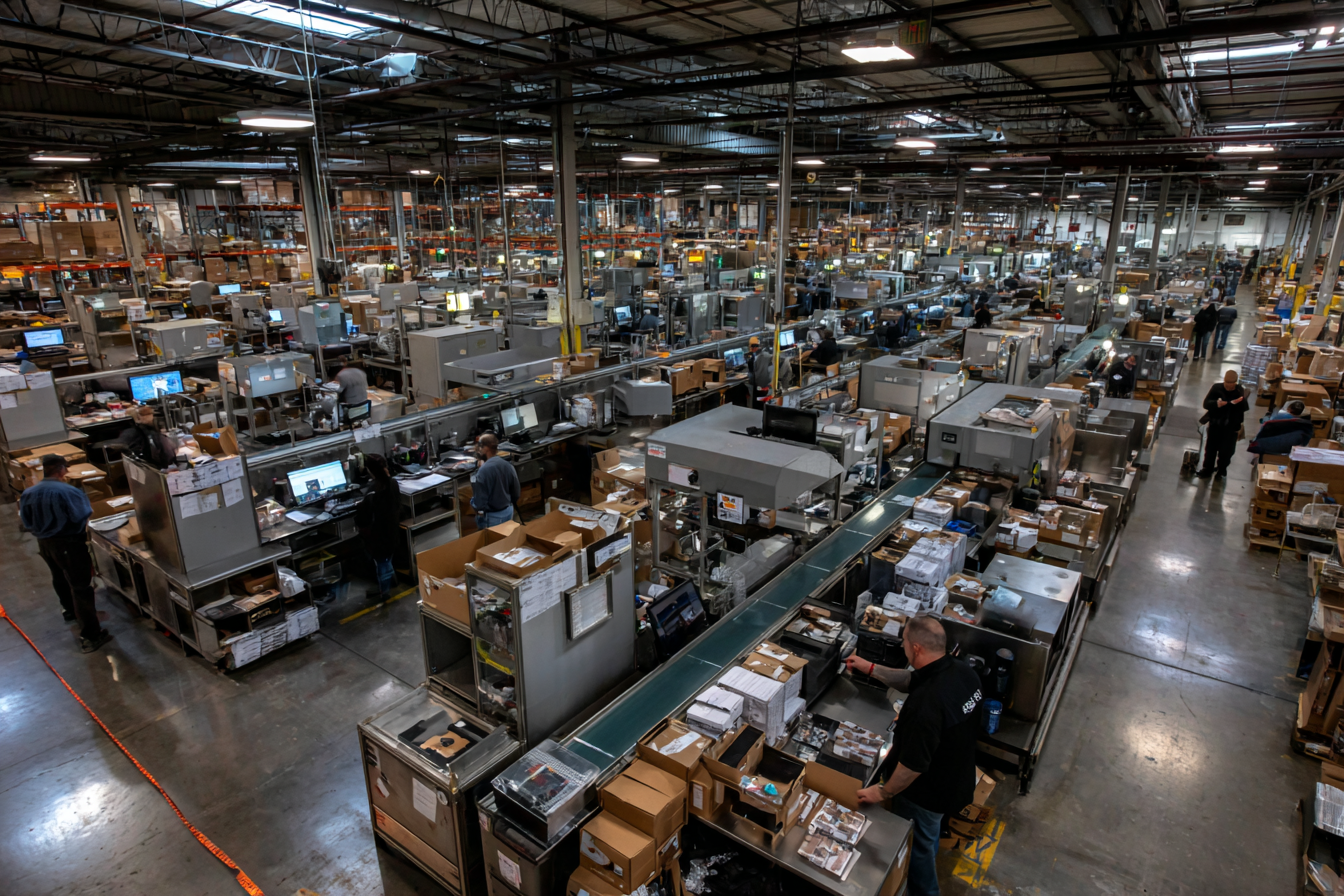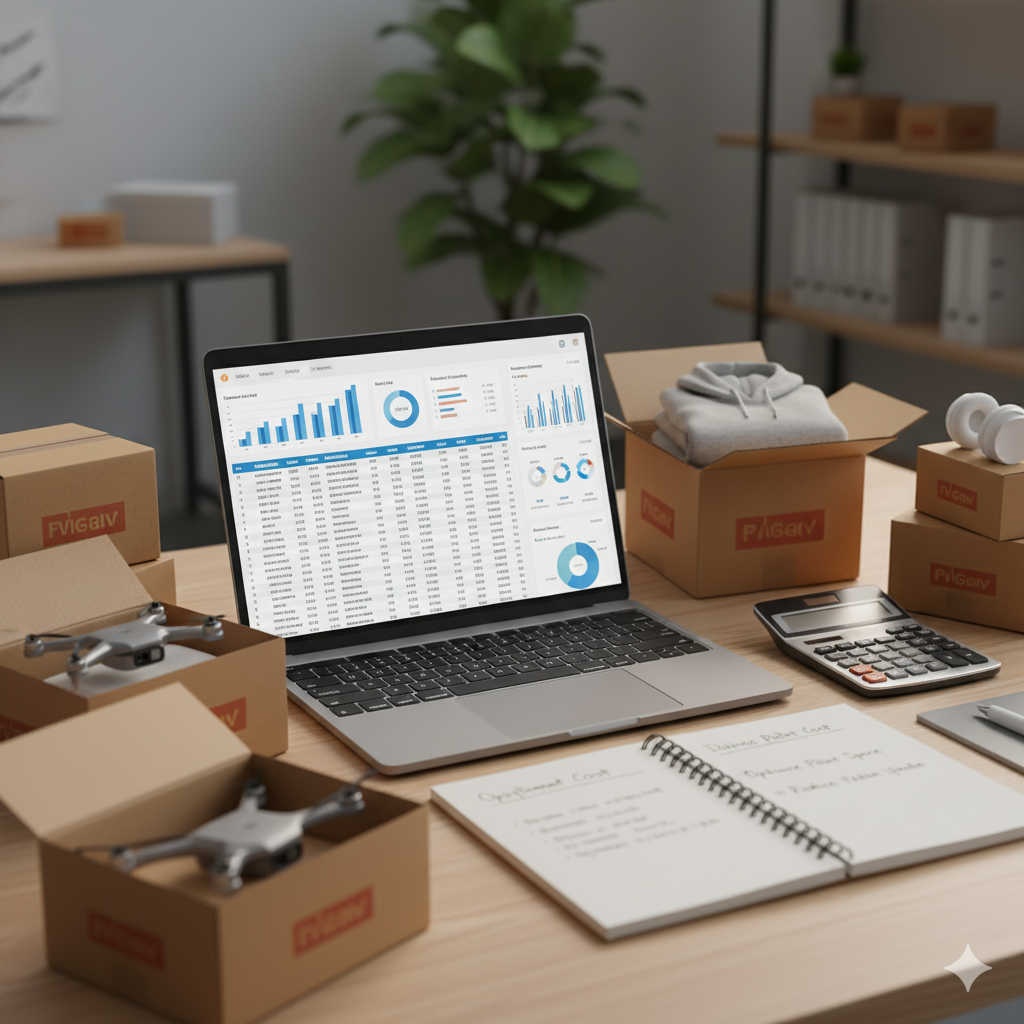How much does 3rd party fulfillment cost? The simple answer is that it depends. Your pricing model, monthly order volume, and cross-border shipping strategy can significantly change your final per-order cost. Relying on a simple fee list can turn a healthy profit margin into a thin one.
This guide provides a clear roadmap for understanding the true cost of third-party fulfillment. We’ll show you how to choose the right pricing model, calculate your landed cost per order, and leverage volume benchmarks. You’ll also learn how to optimize shipping from Canada to the US and negotiate better terms to protect your profits. With real-world examples, you’ll see how to make your fulfillment strategy a driver for growth.
Key Takeaways
- To understand 3PL costs in 2025, you need to go beyond fee lists. Focus on landed-cost scenarios, volume benchmarks (from 2,500 to 50,000+ units), and region-specific strategies like Canada-to-US shipping to protect your margins.
- Match your pricing model to your business needs. Transactional pricing works for low volume, flat-fee models suit predictable products, and hybrid or tiered models unlock savings as you scale. The right choice depends on your average order value (AOV), product complexity, and monthly units.
- Calculate your true landed cost per order by accounting for every line item. This includes receiving, storage, pick & pack, kitting, returns, FBA prep, shipping, duties, and packaging. A detailed formula prevents surprises and clarifies your actual profit margin.
- Use volume benchmarks (2,500 to 50,000+ units) to forecast savings. Per-order costs decrease significantly as you scale. Modeling different volume tiers helps you identify the point where your unit economics become profitable.
- Optimize Canada-to-US shipping with domesticated shipping. Strategies like consolidated shipping and smart customs planning can dramatically reduce your landed cost compared to standard cross-border methods.
- Negotiate your fulfillment contract with growth in mind. Identify hidden fees, set caps on charges, and use volume-based triggers to secure better pricing as you grow. A partner like Evolution Fulfillment aligns pricing with your success to preserve margins.
Who This Guide Is For
This guide is designed for ecommerce brands shipping between 2,500 and 50,000+ units per month. Your average order value (AOV) is likely between $60 and $150, with two to three items per order. If you’re an apparel, cosmetics, or similar brand selling directly to consumers, through wholesale, and on Amazon, these benchmarks and strategies apply to you.
What is a Third-Party Fulfillment Service?
Before we dive deeper, let’s clarify. A third-party fulfillment service is a partner company that handles your logistics. They store your inventory, receive new stock, and then pick, pack, and ship orders to your customers. These services also manage returns and can offer specialized tasks like kitting. They connect to your sales channels through technology like a Warehouse Management System (WMS) or APIs to streamline the entire process.
Pricing Models: Match the Structure to Your Order Profile
Choosing the right pricing structure is more important than chasing the lowest sticker price. Your choice can impact your costs significantly as your business evolves. How much does 3rd party fulfillment cost? It starts with the model you select.
- Transactional Pricing: You pay for each activity, like receiving a pallet or picking an item. This model is flexible and great for businesses with low or unpredictable order volumes. However, be mindful of “add-on creep,” where small fees for things like labels or extra picks can accumulate.
- Flat-Fee Pricing: You pay a single, predictable rate for each order. This works well for brands with simple, consistent products. To avoid surprises, make sure your agreement clearly defines what’s included, especially for packaging, inserts, and returns.
- Hybrid & Tiered Pricing: These models combine elements of the other two. Tiered pricing, for example, reduces your per-order cost as your volume hits certain milestones (e.g., 10,000, 25,000, or 50,000+ units). A hybrid model might include a flat base fee plus a variable cost for each pick, saving a brand with 10,000 orders and 2.5 picks per order up to 14%.
The 3PL Cost Stack: Building Your Landed Cost
Your true fulfillment cost is a collection of individual fees, not a single number. On average, you can expect to pay $8–$15 per domestic order and $11–$19 for a cross-border order. This includes picking, packing, packaging, and shipping.
However, factors like dimensional (DIM) weight can increase costs. A light but bulky item might be billed at a higher weight, adding $1–$2 per package. To get an accurate picture, you must break down every potential charge.
Here are the core line items to account for:
- Receiving & Inbound Prep: $35–$55 per hour or $6–$20 per pallet.
- Storage & Inventory Management: $15–$30 per pallet or $1–$3 per bin monthly.
- Pick, Pack & Value-Added Services (VAS): The first pick is often $1.10–$2.40, with additional picks costing $0.25–$0.60. VAS like special kitting or FBA prep can add $0.30–$0.80 per unit.
- Packaging Materials: The cost of boxes, mailers, and filler.
- Shipping & Surcharges: The carrier rates plus any fuel, residential, or peak season surcharges.
- Returns & Refurbishment: Processing a return can cost $1.50–$3.50 per order.
- Duties, Tariffs & Brokerage: Fees for cross-border shipments.
- Technology & Support: Monthly fees for software integrations and account management.
The Landed Cost Formula (and an Example)
To compare fulfillment partners accurately, use this formula to calculate your landed cost per order.
Landed Cost per Order = (Receiving + Storage Costs) / Total Orders + Pick/Pack Fees + VAS Fees + Packaging + Shipping + Duties/Brokerage + (Returns Cost x Return Rate) + Tech Fees
Example Calculation:
Imagine one order. The pick/pack fee is $1.60, packaging is $0.45, and shipping is $7.20. Add allocations for duties ($0.40), returns ($0.35), storage/receiving ($0.20), and tech ($0.10).
$1.60 + $0.45 + $7.20 + $0.40 + $0.35 + $0.20 + $0.10 = $10.30 per order
Use this formula to model different scenarios and compare quotes on an apples-to-apples basis.
Benchmarks by Volume Tier (2.5k → 50k+ Units/Month)
As your order volume grows, your per-unit costs should decrease. Here are some typical 2025 benchmarks:
- First Pick Fee: Around $1.80 at 2,500 units, dropping to $1.20 at 50,000+ units.
- Additional Pick Fee: From $0.45 down to $0.25.
- Pallet Storage: From $24 per pallet down to $16.
- Pallet Receiving: From $16 per pallet down to $8 (with proper compliance).
Moving from 10,000 to 50,000 orders can reduce your operational costs by 20–30%. Model these tiers to project when your margins will improve.
Worked Scenarios: From Break-Even to Profitable
Strategy matters more than a low sticker price. Here are four real-world examples:
- Scenario A (2,500 DTC Orders): An apparel brand switched from standard cross-border shipping to a domesticated strategy. Its per-order cost dropped from $12.80 to $10.90, adding 2.2 points to its profit margin.
- Scenario B (10,000 Orders): A brand leveraged tiered pricing and carrier incentives to cut operational costs by 18%. Better returns processing also improved the resale of returned goods by 8–12%.
- Scenario C (50,000+ Orders): A multichannel brand used a hybrid pricing model, automation, and optimized cartonization to lower its pick/pack cost to under $1.10. SLA credits offset any service misses.
- Scenario D (Wholesale + 5,000 DTC Orders): This brand focused on avoiding retailer chargebacks, saving 1–3% of its wholesale revenue.
Canada→US Optimization: Protecting Your Margin
For Canadian brands shipping to the US, optimization is critical. Your strategy depends on your AOV, US order density, and where your customers are located.
- Section 321: This rule allows US residents to import up to $800 worth of goods duty-free. It’s a great option but requires disciplined shipping operations.
- DDP + US Injection: For brands with over 4,000 US orders per month, shipping in bulk to the US Delivered Duty Paid (DDP) and injecting parcels into a domestic carrier network can cut per-parcel costs by 8–15%. One brand saved $2.10 per order this way.
Hidden Fees and Contract Pitfalls
Unexpected fees can erode your margins. Watch out for these common charges:
- Address correction fees: $18–$22
- Peak season surcharges: $0.40–$1.20 per package
- One-time EDI setup fees: $500–$1,500
- Non-compliance penalties: $25–$75 per incident
Checklist to Avoid Leakage:
- Define fee caps and approval workflows in your Statement of Work (SOW).
- Set maximum monthly budgets for chargebacks and testing.
- Require transparent reporting on all passed-through surcharges.
Negotiation Playbook: Aligning Price with Growth
Come to the negotiation table with data and KPIs to align your 3PL’s pricing with your growth.
- Provide a Forecast: Give a 12-month forecast of your orders, shipping zones, and picks per order.
- Request SLA Credits: Ask for credits (5–10% of fees) if your 3PL misses service-level agreements (SLAs).
- Tie Pricing to Volume: Negotiate automatic price reductions when you hit volume triggers at 10,000 and 25,000 orders. This helped one brand lower its per-order costs by 22% in nine months.
3PL vs. Amazon FBA: Which to Choose?
You can and should use both where they make sense. Fulfillment by Amazon (FBA) is great for your top-selling products on the platform, but its storage fees can be high during peak season ($2.40–$6.90 per cubic foot), and restock limits can be a challenge. A 3PL offers flexibility for multichannel sales, custom branding, and kitting. Using FBA for top ASINs and a 3PL for DTC and other channels helped one brand cut its total landed cost by 9%.
Who is the biggest 3PL company?
While global carriers and logistics giants dominate the market by revenue, the biggest company is not always the best fit. A better question is: who is the right partner for your brand? The right 3PL is one that understands your business, models your landed cost, and aligns its services to protect your margins.
Evolution Fulfillment’s Brand Fulfillment Model is built on this principle. We combine robust technology, Canada-US domestication expertise, and SLA-aligned pricing to lower your costs and reduce errors. Our goal is to preserve your margin as you scale.
Frequently Asked Questions
How much does 3rd party fulfillment cost per order in 2025?
For direct-to-consumer (DTC) brands, expect $8–$15 for a domestic order and $11–$19 for a cross-border one, including shipping. Your final cost depends on your complete landed-cost calculation.
What fees should I expect from a 3PL?
You should expect fees for receiving, storage, pick/pack, packaging, shipping and surcharges, returns, duties, and technology. You may also see fees for value-added services.
How do I calculate landed cost including duties?
Use the formula provided above. Be sure to include any brokerage or DDP fees and allocate fixed costs like receiving and storage across your orders.
The Right Partner Protects Your Margin
The cost of third-party fulfillment in 2025 is not about a single rate. It’s about a fully modeled landed cost that accounts for your AOV, items per order, return rate, and cross-border strategy. The typical $8–$19 per-order range is just a starting point.
By choosing the right pricing model, calculating every line-item fee, and negotiating volume-based discounts, you can compress your costs as you scale. For Canadian brands, smart domestication strategies can add several points to your margin. The key is to find a partner who helps you manage these levers.
Ready to see how these strategies can impact your bottom line? Explore Evolution’s Canadian warehouse and domestication services to see how we help brands preserve their margins.
Discover the path to smarter logistics and greater profitability with Evolution Fulfillment. Visit Evolution Fulfillment to learn more about how our Canadian warehouse and domestication services can transform your business operations.
Take control of your costs, streamline your processes, and protect your margins today. Contact us now to get started!

